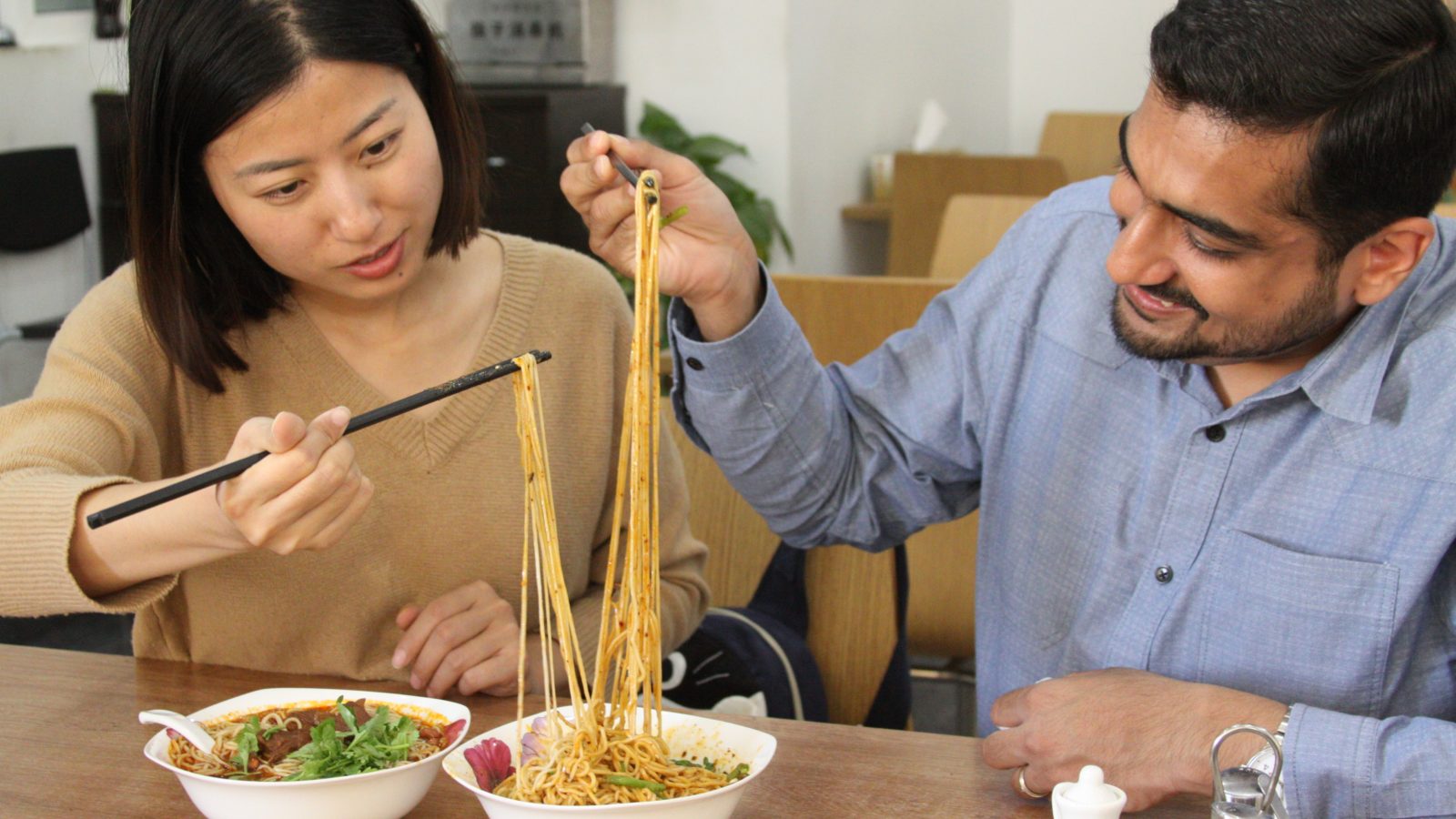These 5 Chinese restaurants in Dubai serve must-try noodle dishes
If you’re looking for an authentic Chinese restaurant in Dubai that serves a mean bowl of noodles, you can take comfort in the fact that there are many options, especially in International City. That said, there are some regional specialties, and not every Chinese restaurant serves all of them. We asked two resident Chinese food aficionados, Xini Weiand Jing Leng, about their favourite noodle dishes and where to find them in the city. Tune in to hear what they have to say using the podcast player below, or continue reading through this post for the names of the restaurants and dishes, as well as the entire podcast transcript.
Do’s / Dont’s for your Chinese Noodle Adventures
A few pieces of advice from our Chinese food gurus if you’re planning a noodle adventure to International City where it’s sometimes a challenge to understand the menus:
- DO your homework before you. Research online (or hear our podcast / read the post below!) because each restaurant has a different specialty.
- DO ask the owner what their specialty is, assuming they speak English.
- Do pick the first one or two dishes from any menu category you’re trying to order. More often than not, those are the restaurant’s best-selling dishes. So when in doubt, go with those!
- Most importantly, DON’T be offended if you hear other diners noisily slurping their noodles! This is a sign of enjoyment and if you want to show you appreciation, then go ahead and slurp too!
Read on for the list of restaurants and noodles that Xini and Jing shared with us.
Want more of our scrumptious podcast episodes? Feast on our main podcast page here!
Subscribe on: Apple Podcast App | Spotify (available on AppStore and Google Play) | Google Play Music(currently supported only for listeners in US/Canada) | Anghami
1. SHANGHAI-STYLE COLD NOODLES AT HOME NOODLE RESTAURANT (回家冷面)
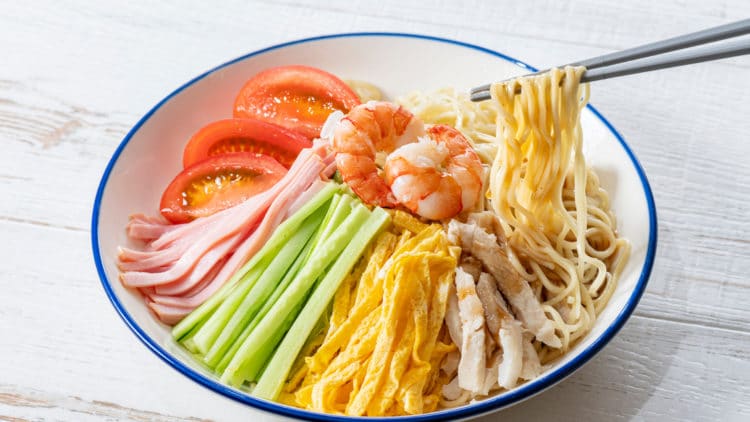
Xini claims that these cold egg noodles make for a “perfect lunch for sticky hot summer day in Shanghai”—or in Dubai! Learn more about these noodles by tuning into our podcast above.
Try them at Home Noodle Restaurant in International City (回家冷面).
2. STIR-FRIED TOMATO & EGGS NOODLE AT CI WU RESTAURANT (次坞打面)
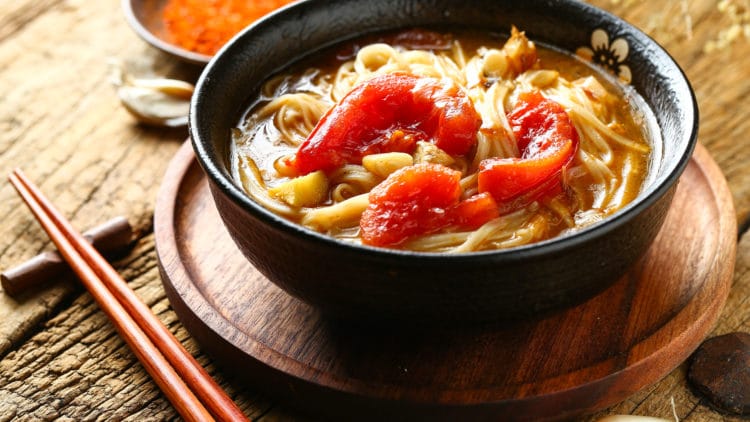
Jing says that stir-fried tomato and eggs noodles is so easy to make that it’s the first thing some children in China learn how to cook! Hear her recipe on our podcast.
But if you don’t feel like bringing the water to a boil, then Jing recommends heading over to Ci Wu (次坞打面) in Cluster C of International City. “It’s a family-run business and I love the noodles in general because the noodle is handmade by the owner every day. It’s so fresh and the broth is just, it’s like heaven to me. I love it so much.”
3. CROSS BRIDGE NOODLES AT YUN LI DUO
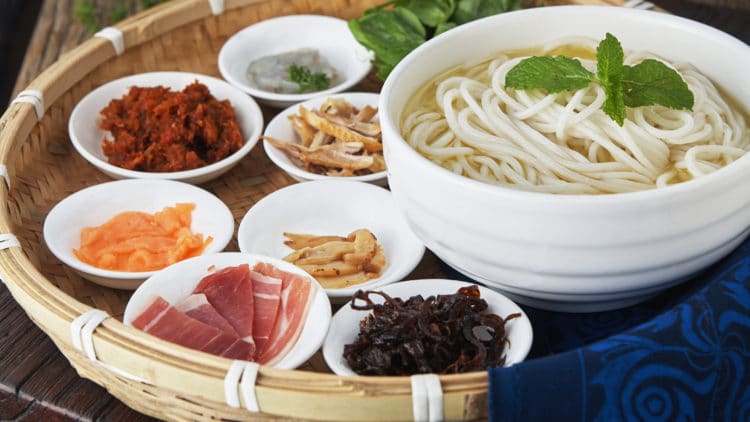
Xini describes this wonderfully complex and layered noodle dish as one that you have to assemble at the table. She shares that “the broth is traditionally made of bone. And so it has a thin layer of oil on the top and the oil keeps the boiling soup hot for a long time. And then once you have the topping dishes, you will put them one by one. So the first you put the raw meat, like the chicken breasts, the soaked squid, and then you put the vegetable like tofu skin, leaks, and the sprouts. And then afterwards you will put the pickles, the quail eggs, and then last, you will put the half cooked rice noodle into it. And then season it with chili powder. Or salt and pepper. And it’s very entertaining to see how it’s made in front of you because there’s so many different dishes. And it also has a beautiful story behind it.” Hear the story of the dedicated scholar and his ingenious wife on the podcast above or read it in the transcript below.
Try this dish at Yun Li Duo (rebranded from Xiao Ding Shi) in International City.
4. RIVER SNAIL RICE NOODLES AT ORIENTAL GASTRONOME
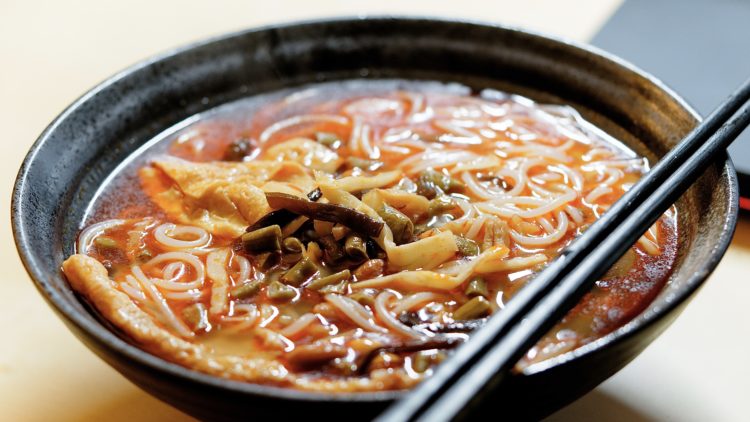
This ‘stinky’ noodle dish hailing from Liuzhou city in the Guangxi province has become quite trendy in present Chinese noodle circles. Jing attributes the stinky smell to both the river snails (yes, actual snails in the sauce!) and sour bamboo shoots, but if you can get past the smell, she guarantees you’ll be rewarded with an incomparable savoury, spicy, pungent flavour. The best part of the dish is the unique chilli oil that is unique to Liuzhou city.
On the podcast, Jing shared that this dish is finally available at a restaurant called Oriental Gastronome in the Greens. It’s listed on their business lunch menu under the loosely titled dish: Hot and Sour Noodle Soup. We tried it out together with Jing and the sour, pungent, spicy flavour lived up to everything Jing described!
Jing also showcased a packaged version that you can make at home, but skip buying it online and buy it at a fraction of the cost at our favourite Chinese hypermarket Wemart in Deira.
5. LAN ZHOU LA MIEN AT YI QUNG SHUN RESTAURANT (伊清顺西域美食)
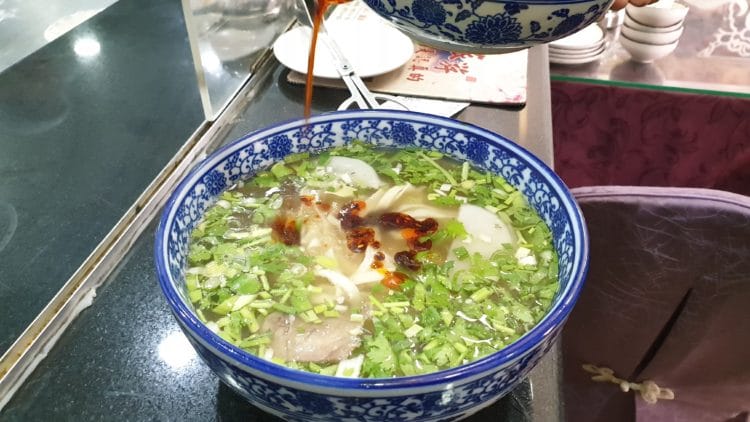
Lan Zhou La Mien is such a ubiquitous noodle dish in China that Xini refers to it as the “long standing Chinese version of KFC!” Whether in Dubai or in China, it’s typically served by the Chinese Muslims (Hui community) and is a safe bet for anyone looking for a halal bowl of noodles. Try this dish at Yi Qing Shun Restaurant (伊清顺西域美食)—also a Chinese Muslim restaurant—in International City.
On the podcast, Xini shares that the beauty of Lan Zhou La Mien is both in its clear broth made from beef bones as well in how the colours of the various ingredients—”white radish, red chilli oil, green coriander and yellow garlic and the noodles”—mix together in the broth.
Not a fan of audio? Here’s the show transcript for you to read!
- Our Speakers’ Background: Provinces and Flavours of China
- 5 Chinese Noodle Dishes You’ve Got to Try
- Cold Noodles from Shanghai
- Stir-Fried Tomato and Eggs Noodle
- Cross Bridge Noodle from Yunnan
- Luosifen or River Snail Rice Noodles from Guangxi
- Lan Zhou La Mien by the Chinese Hui Community
- Tips on Ordering at Chinese Restaurants in International City
Arva: This show is brought to you by Dubai’s most gluttonous food tour company, Frying Pan Adventures and you’re listening to Deep Fried.
Hey there I’m your host Arva Ahmed. And thanks for joining me on the show that’s inspired by flavours of the East. This podcast celebrates the flavours that we as storytellers, content, creators, and food tour guides with Frying Pan Adventures have discovered in Dubai.
And on today’s show we’re going to twirl our minds around noodles. We’re going to be looking specifically at five Chinese noodle dishes that you’ve got to try in Dubai cause over the decades, the number of Chinese restaurants in the city has not just exploded, but we’ve seen a more nuanced representation of the different provinces of China across the restaurants here, especially in International City.
So I’ve got two very dear friends of our team here at Frying Pan Adventures. These two ladies also happen to be serious Chinese food lovers, and they’ve actually helped us host Chinese food experiences right here in Dubai.
So first up is Xini Wei. If you’ve heard Season One of our podcast, you’ll remember her from this episode that we did on crazy good Chinese hotpot in the city. And last summer, she took us on a two day food binge through all of the most bizarre foods that you can find in International City. Now while her love for food is enough to be a fulltime affair, she actually does have a non-food life too. She’s a marketing tech expert by profession and a keen hiker and sportswoman by passion. Hey Xini, so good to have you here.
Xini: Hi Arva, so good to be here.
Arva: Well, thank you for joining us. All right so this next lady is someone who takes life by all its carbs, head-on! Jing Leng is this soft spoken powerhouse of Chinese food knowledge who actually ran our totally sold-out tour of noodle dishes through International City back in 2019. And when she’s not testing recipes at home or exploring new foods out in Dubai, she’s actually hard at work as a Chinese digital payment and retail professional here in Dubai, where she’s been living for the past 11 years.
Hey Jing, welcome to the show.
Jing: Hi Arva, pleasure to be here.
Our Speakers’ Background: Provinces and Flavours of China
Arva: Okay. So ladies, before we talk noodles, let’s get some context. Can you each tell us what province of China you’re from and what sort of flavours it’s known for?
So Jing, why don’t you get us started?
Jing: Sure. I am from Sichuan province, a place people prefer eating spicy foods, and because of Sichuan paper also have that numbness flavour in all those Sichuan cuisines.
Arva: And that characteristic flavour profile of the Sichuan provinces is ma la. Am I right?
Jing: Yeah.
Arva: So it’s like this numbing and hot, spicy flavour profile that is typically associated with the Sichuan province. Okay. That’s great. So we, we know which fiery road you’re going to be headed down with your noodles.
And Xini, what about you?
Xini: So Shanghai is my hometown and its history is: it was a very small fishing village into, you know, early 19th century. And people come from nearby provinces, start to migrate there. And the most authentic Chinese cuisine has a very strong soya sauce flavour and sweet flavour in it. So I remember my mom and grandma’s kitchen always have a few type of soya sauces, like one for coloring and the other for flavouring and another one for spicy soya sauce for schnitzel dipping. And we also, we also put lots of rock candies in the dish. And seasonal vegetable and seafood food are quite typical in our cuisine, like both from the sea, in the river. So I remember we usually like chase young bamboo shoot in the spring and eat the river crab as delicacy in autumn.
So there is a time to eat everything. That’s probably one thing I miss being away from home. And coming back to the Shanghai cuisine, it kind of evolves over the time because it’s kind of quite sweet for the young generation. So it kind of absorbs the savoury flavour from the nearby provinces and its become a kind of fusion nowadays.
Arva: You know people talk about Chinese food as one generalized category. And just the two of you have shown us that there can be such variation because it’s such a massive country. And obviously you’re going to have pockets of different flavours. So hopefully the noodles, the noodle dishes that you’re going to share with us will also reveal some of these pockets of flavours.
So let’s jump right into this bowl of noodles that we get here in the city. I want us to talk about five Chinese noodle dishes that we can find here in Dubai and our lives are just going to be incomplete until we try them.
So Xini, you’re already on a roll. Why don’t you give us the first one?
Cold Noodles from Shanghai
Xini: So the first one, I would probably just talk about cold noodles from my hometown, from Shanghai. It’s not a famous one compared to, you know, all the big names in the markets, but it kind of stuck in my deepest memory as part of the childhood and my summer vacation. It’s quite easy. So it’s a egg noodle and you boil it and you sieve it.
Then you put it under the big fan to cool it down. While cooling it down, you kind of air it using your chopsticks so they won’t stick together. That’s the one thing about wheat noodle is they tend to stick together if you don’t separate them when they are hot. Then when they’re cooled down, you can separate them and put in the fridge and whenever you need it, you take it out.
Put a mix of sauce of the peanut sauce, sesame sauce which is similar as tahina and soya sauce, vinegar and a little bit, you know, salt and like pepper and whatever seasonings you want. And then the leftover topping from last night or quick pan fry food, that’s a perfect lunch for sticky hot summer day in Shanghai.
So you can probably find that in one of the cold noodle restaurants in International City close now to that flavour, which reminds me of home all the time.
Arva: And what’s the name of the dish and what’s the name of the restaurant?
Xini: So the dish is called cold noodles and the restaurant’s name is called Home Cold Noodles. I think that’s probably the translation of Chinese name, but I can’t be a 100% sure…
Arva: Wait, is it just, is it called cold noodles in Chinese? Like is that what it’s called? Because I thought you were going to give this really complicated name and you’re like, it’s called cold noodles.
Xini: It’s called Cold Noodles as it is.
Arva: Like this is not just the name you’re giving us as foreigners? Like this is the name that everyone just calls it?
Xini: Yeah, it’s by its name. Everyone can understand.
Arva: Yeah. You know, that’s the interesting thing is whenever people think of noodles, I think most people don’t think of the cold version. Like you think of a hot steaming bowl of noodles. But on a hot summer’s day, the kind of dish you described sounds like it’s perfect. And I think it’s also interesting that you pointed out that you could put in the Chinese version of tahina, the sesame seed paste. I think we need to do a whole episode comparing the Middle Eastern version of tahina with the Chinese version of tahina and the uses, because I was really fascinated when I saw a tahini based sauce in a Chinese restaurant. It was just totally unexpected and it tastes so delicious with noodle dishes.
Xini: Yeah, it is. I think probably at the end, they all come from the same root somewhere.
Arva: Probably. So that was our first dish. Jing, do you want to give us our second?
Stir-Fried Tomato and Eggs Noodle
Jing: Yes. I would say, stir fried, stir fried tomato and eggs noodle. That is my favourite. It is my childhood comfort food. So it always reminded me my childhood and it always comforts me if, like bad or sad happened.
Arva: So you’ve been eating a lot of it during COVID basically!
Jing: That’s true. That’s true. And I make different, mashups as well. Stir fried tomatoes and eggs is very commonly served in China because it’s very simple to make. And it becomes one of the few dishes to start with for kids who start learning cooking.
And that is the first dish my mom ever taught me. So you just need very simple ingredients, tomatoes and eggs.
Arva: So are you scrambling the eggs with the noodles or how are you incorporating the eggs into the dish?
Jing: I will say that’s really depends. on your own preference. For me, I just pan fried it and, yeah, first of all you need to stir fry the eggs and you’ll put it aside. And you stir fry tomatoes until tomato becomes juicy and soft and you add eggs. I put sometimes soy sauce and sometimes salt.
But you could take this as a main course. So it can have different combinations.Someone wants to have rice as a side and some would, have noodles without soup. But my favourite is to do the soup. So I will have tomato eggs noodle soup. It’s just so perfect for me. I think that is so simple for me as well. Number one, I don’t need to use another pan or pot to boil rice or like, I don’t need to drain my noodle.
So I just stir fry everything I have, tomato and eggs and add water. Once the water boils, I just add noodles. And I would add some pak choi as well because we love vegetables. I will say it’s the best dish I can make so far. That’s why I love it so much.
Arva: And what kind of noodles are you using? Does it matter?
Jing: It doesn’t matter actually, so I just use whatever I have. Sometime its dry noodles. And sometimes I got the fresh noodles I bought from the supermarket. So I use different kinds of noodles. That really depends on what you have that time.
Arva: Yeah I like that the dish is so flexible and it definitely sounds like comfort food. What is the technical name of the dish and where do we find it in the city? Or is it just something that you prefer to make at home?
Jing: Actually I think I would call it Ci Hung Shi Da Mian. So in English it will be stir fried tomato and eggs noodle. Actually I was suggested to, make it at home because if you go to the Chinese recipe website, you’ll find a lot.
And if you live in Dubai, you’ll find a few restaurants in International City making this. But I would recommend go to the, the one in International City. I think that is Cluster C. The noodle house is called Ci Wu Da Mian. It’s a family-run business and I love the noodles in general because the noodle is handmade by the owner every day. It’s so fresh and the broth is just, it’s like heaven to me. I love it so much.
Arva: Well that’s fantastic. And I know that the names are quite the tongue twisters. So don’t worry. We will compile a list of all of these and make sure that we put it on our blog section so you can check out some of these noodle dishes yourself. All right. We are going to take a quick break. And when we’re back, we are going to continue slurping on some of the delicious noodle dishes that you can find across Dubai.
<break>
And we are back to our bowl of Chinese noodles with our two Chinese friends and food aficionados, Xini Wei and Jing Leng. Alright, so Xini you’re up next again. As a quick reminder, we’re talking about some of the must try Chinese noodle dishes in Dubai. What’s your next one for us?
Cross Bridge Noodle from Yunnan
Xini: Okay. So if Jing was talking about the simplicity of noodles, the next one I’m introducing is the complexity. So it is the Cross Bridge rice noodle from Yunnan province. At the border of Myanmar and Laos. In spite of the great variety of food there, the Cross Bridge noodle is one of the most famous dishes from Yunnan province.
It’s a large bowl of clear broth and over 12 dishes of meat and vegetable will be served on a table and you can make the noodle yourself.
Arva: DIY noodles. Love that. Okay.
Xini: Yeah, so the bowl goes through boiling water to keep the heat. And the broth is traditionally made of bone. And so it has a thin layer of oil on the top and the oil keeps the boiling soup hot for a long time. And then once you have the topping dishes, you will put them one by one. So the first you put the raw meat, like the chicken breasts, the soaked squid, and then you put the vegetable like tofu skin, leaks, and the sprouts. And then afterwards you will put the pickles, the quail eggs, and then last, you will put the half cooked rice noodle into it. And then season it with chili powder. Or salt and pepper. And it’s very entertaining to see how it’s made in front of you because there’s so many different dishes. And it also has a beautiful story behind it.
It was said a scholar, he, studied so hard and he isolated himself on an island. And his wife had to cross a bridge to reach that island to serve food for him. And he studied hard so he always left the food cold. And one day his wife was cooking chicken soup and she realized if she keeps the chicken oil on top of soup will keep it hot for a long time.
So what she does is she brings the hot soup as well as the raw ingredients in separate bowls. And once the scholar feels hungry, he can put everything together and cook the noodle on his own. And at the end, he successfully passed the exam and it become a legendary story for the, for noodles. There are different variations of the story.
We don’t know which one is true, but it’s entertaining to, you know, just to watch how it’s made. So it’s called crossing bridge rice noodle for a reason.
Arva: Oh, what a thoughtful wife. I wish I had that before my exams.
Xini: Next time. So you can actually try it in the International City. There is a Yunnan restaurant serving crossbridge rice noodle. But I think they just recently rebranded and changed the name. So I will figure out the new location and name and send it to you later. But they, because of Dubai, they don’t use pork bone, but instead chicken broth only, but it’s still very still very yummy.
Post podcast update: The name of the restaurant used to be Xiao Ding Shi and it is renamed to Yun Li Duo.
Arva: I was going to ask you that. Yeah. So it’s going to be a Halaal version basically of…
Xini: Yes exactly, it’s still yummy!
Arva: Right. So we’ve got to cross the bridge and you got to try those noodles. You’re going to share the place with us. Jing, what do you have for us?
Luosifen or River Snail Rice Noodles from Guangxi
Jing: Yeah, see, I want to show you this. Actually I’m going to introduce, I will say the most popular rice noodle in China right now and probably, overseas as well And it’s called luosifen. Actually if we say it in English, it will be river snail noodle, rice noodle.
Arva: Okay.
Jing: So, this was my favourite in college because I studied in Guangxi and luosifen comes from Liuzhou city in Guangxi. So when I was first time introduced to luosifen was in the, I think the first day of my college, I was eating out with my new classmate and she’s from Liuzhou city.
She said, okay, let me take you to my hometown specialty, which is luosifen. I hope you like it. But when we’re approaching the restaurant, she said, “Oh, maybe let’s forget it. Maybe we do next time.” I said, “Come on. What, what is it?” “Oh, I, I think you might not like this smell because it’s very stinky.”
I said, “Okay, let me try it out.” Yes. It’s very stinky this smell, but honestly the flavour is just, it’s so overwhelming and its taste wasn’t at all as I was expecting, It turned out to be very, very, savoury and simultaneously spicy, pungent, earthy and, I cannot describe, I just fall in love with this rice noodle immediately.
Arva: Okay, wait so you’re holding a packet of these noodles.
Jing: Actually, they have so many brands, because now they made it ready to serve. They have different brands coming from Liuzhou city, the same, place where they produce this. I, I think I left college 11 years ago. I was very sad at that time and it won’t have the rhythm because I thought I will never have such rice noodle if I don’t go back.
But I found this. So I tried like 10 different kinds of such package already and at least, take one once a week. So it’s still my favourite. And I think, not only this river snail makes the sticking smell, but also I think the sour bamboo shoots also contribute to this smell, this very special smell. I love it so much. And I recently found out there is a restaurant in Dubai, it’s serving this.
Arva: Okay tell us!
Jing: Yeah. And that’s good news for a lot of people live in Marina, JLT and Barsha because this restaurant is in the Greens. It’s called Oriental something, I forgot the name, but I check it out for you later. So I found out this on the menu. So that means we can have fresh…
Post podcast update: The restaurant is called Oriental Gastronome.
Arva: River snail.
Jing: Yes.
Arva: Okay. So I just want to back up a little bit. You’re holding this packet of river snail noodles. It’s got only the noodles in there, or it has the entire mix?
Jing: Okay so I’m going to open this in front of you.
Arva: I wish we could smell this.
Jing: So we can explore
Arva: Okay let’s open it.
Jing: Okay so we see this is this rice noodle. It’s quite big, very savoury and I would say very chewy. So you need to cook it and maybe I will say if you want to have soft noodles, I would suggest you to cook it at least maybe 10 minutes. And this one is, you cannot see it from the package but it’s fried peanuts and tofu skins.
Arva: Oh I love…I love tofu skins. They’re like chewy and
Jing: Yes and crunch .
Arva: Okay. So this one is deep fried so it’s crunchy. Okay.
Jing: Yes. And this is black fungus. So sliced and pickled.
Arva: I love black fungus because it adds that cartilaginous texture, you know? It’s some mix between crunchy and a little bit elastic. I love black fungus.
Jing: And I, every time I eat it, I tell myself, “Oh, this is healthy, I’m eating healthy. It’s like reducing my guilt having a lot of carbs. Yeah. So this is vinegar. So it adds to the, you’ll find a sour flavour in the dish as well. And this is the sour, bamboo shoots. Also gives you that very stinky smell.
Arva: It looks like a little Pandora’s box.
Jing: And this is pickled radish. I like it. And, this is the, I will say the highlight is always the, chilli oil. It’s such a special chilli oil and I think this takes the whole dish to a much higher level. So you have to have the chilli oil. It’s spicy, pungent, but you will get addicted.
Arva: Love that.
Jing: Yeah, and this is the river snail sauce. I will say this is stinking as well but you cannot do without it if you want to have a proper river snail rice noodle .This is essential. Yeah.
Arva: So wait, this is just to get this right, so this is actual river snails that have been cooked down into a sauce?
Jing: Yes. Correct.
Arva: Okay, got it.
Jing: So actually I will say that the base is still chicken broth but they also add river snail. So you have that flavour and smell. Recently I found out there were some restaurants in UK. They’re also serving this rice noodle at the restaurant, but they give you that big snail. Actually that is not a river snail, a river snail can never be that big.
I will say that is French kind of snail They put two snails on the top of the rice noodle. But actually in this dish, you will never find that kind of snail. Yeah. Maybe small, will find some little, small snail meat there. But not that. It’s not that kind. Yeah, but this is a must try. I will encourage you to try to here in a restaurant.
Arva: Yeah. All right.
Jing: Oh yeah. I found out actually you can buy it online and the price is ridiculously expensive at 75 dirhams per package. That was like crazy, you know, because I bought from the local Chinese supermarket . It’s only 10 dirhams.
Arva: All right. So we’re going to need to know the name of the place where you bought the 10 dirham bag, assuming it’s the same and it’s the same brand right?
Jing: Yeah.
Arva: Wow. Okay. So we’re definitely going to need to know the name of that.
And I love that you can recreate it at home using this very nicely packaged mix. It’s like instant noodles, but a totally different level of instant noodles.
Jing: Exactly. And I heard that at Guangxi province, they even have a college for, for the noodle. They want to improve the management for the whole industry, because they think this is creating a lot of jobs and, brings a lot of revenues to the government, in the local economy as well. So, it’s a very professional thing now.
Arva: Oh my goodness. So you can get like a river snail noodle degree.
Jing: Yeah. Technically yeah.
Arva: All right. In my next life, that’s what’s going to happen. Wow. This was so fascinating. Xini, surprise us.
Lan Zhou La Mien by the Chinese Hui Community
Xini: So if the river snail noodle is the newly trendy noodle, then Lan Zhou la mien is the long standing Chinese version of KFC I would say! You can find Lan Zhou, Lan Zhou la mien, Lan Zhou ramen everywhere, in all the cities because it’s very simple, but it’s so delicious. And it’s a, really a work of art itself. And it’s made of a huge lump of dough and you repeatedly stretching it and folding it, to loosen it up.
After the dough is pulled, you know, several times, you smash them on the chopping board and turn them into noodles. And the noodle chef would do this in front of you and then drop that noodle into the boiling water.
Arva: Oh wow it’s like noodle theatrics! I’ve seen this online and it’s so mesmerizing to watch.
Xini: I would say it’s very difficult cause I used to try it once at home. Like after the first smash it broke, I was like, ugh. It must be the perfect proportion of the flour and water
Arva: Yeah,
Xini: And you have to, you know fold it…
Arva: No, but it’s in their hands Xini, like I’ve seen them. They just go like whack and then suddenly the dough just separates and all of these gajillion noodles. And you’re just like, what kind of sorcery is this?!
Xini: But the beauty of the Lan Zhou La Mien besides the noodle is in its clear soup. So we say there are a few standards for a good bowl of Lan Zhou La Mien. Like it’s a clear soup. It’s white radish, red chilli oil, green coriander and yellow garlic and the noodle. So you can see all the different colors mixed in one bowl of clear broth noodle. And it looks very simple but it tastes so good because the broth is made of the bone of the cow.
And these restaurants are usually owned, they’re operated by the Chinese Muslims, the Hui people, so it’s hundred percent halal so no worries about that at all. Even if you travel to China if you find Lan Zhou La Mien restaurant you know it’s safe for halaal food.
Arva: Okay that’s a really good tip.
Tips on Ordering at Chinese Restaurants in International City
So imagine I land up in International City and I’ve been to a couple of restaurants in International City. The menus can sometimes be a little bit mind boggling. So do you have any advice for someone who steps in there? How do you figure out what to order from the host of Chinese noodle dishes that are available?
Xini: I would suggest that before going there do the homework and write down exactly what you want to try because each noodle house has their own specialty. And you can’t find all of these flavours and all of these noodles in one place.
Like the restaurants Jing was mentioning or they all have the special noodle. So you can ask the owner what is your specialty and they will usually recommend you a pretty safe option.
Arva: Right.
Xini: Oh and one little thing is, there is a kind of culture shock of slurping because slurping is seen as a lack of table manner in Western culture. But it’s a sign of a compliment and enjoyment of noodle eating. And if you hear people like slurp when they eat noodles, don’t feel offended or don’t feel surprised, just go and join them.
Cause that’s the way it is.
Arva: Yeah, that’s going to be me.
No people appreciate it. Cause if you slurp, it means you really enjoyed the noodles and people love seeing others enjoying their food.
Arva: Show the noodle. Your love slurp
Jing: Yes, actually, I totally agree with Xini that you might do some homework before you’re going to any Chinese restaurants in International City. And also, if you look at the menu, if there’s no image, I would suggest you to start with the first two or three dishes in each category. They always put the best seller or like, their specialty, in the front lines.
Arva: Alright, that is fantastic. Frankly, I feel pretty privileged because I know both of you so I am not going to go without either one or both a few by my side to get the best noodle dishes in International City. By the way, what are both of you doing after the podcast? Because suddenly my lunch doesn’t stand a chance against the stuff you’ve just described!
So I think we’re going to have to just go and get some noodles. Plus Jing, you’ve opened up that bag of noodles and I don’t know what you’re going to do with it if two other people don’t help you finish it.
Jing: Okay for sure! But I would like to invite you, like come over to Greens and so we can go to the new Chinese restaurant and to check it out.
Arva: Of course. Well, I’m right outside your door right now Jing! Let’s make it happen. Let’s make it happen. Alright.
Jing: Yeah let’s do it.
Arva: How do people find you two Chinese food wizards online? Are both of you on Instagram?
Xini: I am.
Jing: Yes.
Arva: Okay so Jing, how do people find you on Instagram?
I think they can search Tinhoi, which is my Vietnamese name. So that’s T-I-N-H-O-I. So you can easily find me on Instagram.
Arva: Okay. Awesome. We’ll make sure to share that in our show notes. And Xini?
Xini: So you can find me with X-I-N-I-W on Instagram.
Arva: Alright. So if you have complicated noodle questions, you know who to find. And for the folks who are listening in, you can find all the names of the places and the dishes that Xini and Jing mentioned on our blog at fryingpanadventures.com/blog.
And we’ll share all of that along with a full transcript of the show. So make sure to check it out. And you can connect with us over social at @fryingpanadventures on Instagram and Facebook and @fryingpantours on Twitter.
Hey, I really hope you enjoyed listening as much as we enjoy chatting about noodles on this episode. And if you did please rate view and share the show with your friends.
And before we head off, just know that this is only one of many episodes that we want to do to learn about Chinese food, because in the words of the one and only Fuchsia Dunlop—she’s this incredible English food writer who is both a trained chef from a Chinese Institute in Chengdu and she’s a leading authority on Chinese food culture with no less than five books under her belt. And despite all that, this is what this expert has to say.
I just feel like the more I find out about Chinese food, the more there is to discover. I feel like I’ll be learning my whole life.

Arva Ahmed is the co-founder of Frying Pan Adventures, Dubai’s first food tour company, and a celebrated food explorer known for uncovering Dubai’s hidden culinary gems. Her expertise in the city’s diverse food scene has been featured in prominent publications such as CNN, Khaleej Times, BBC Travel, The Sun, The Independent and countless more. She also hosts Ditch the Silver on YouTube. Through her immersive tours and storytelling, Arva brings Dubai’s rich flavors and vibrant cultures to life.

